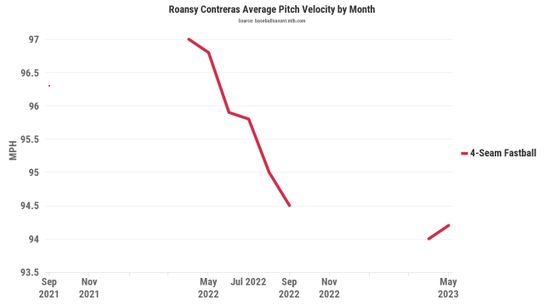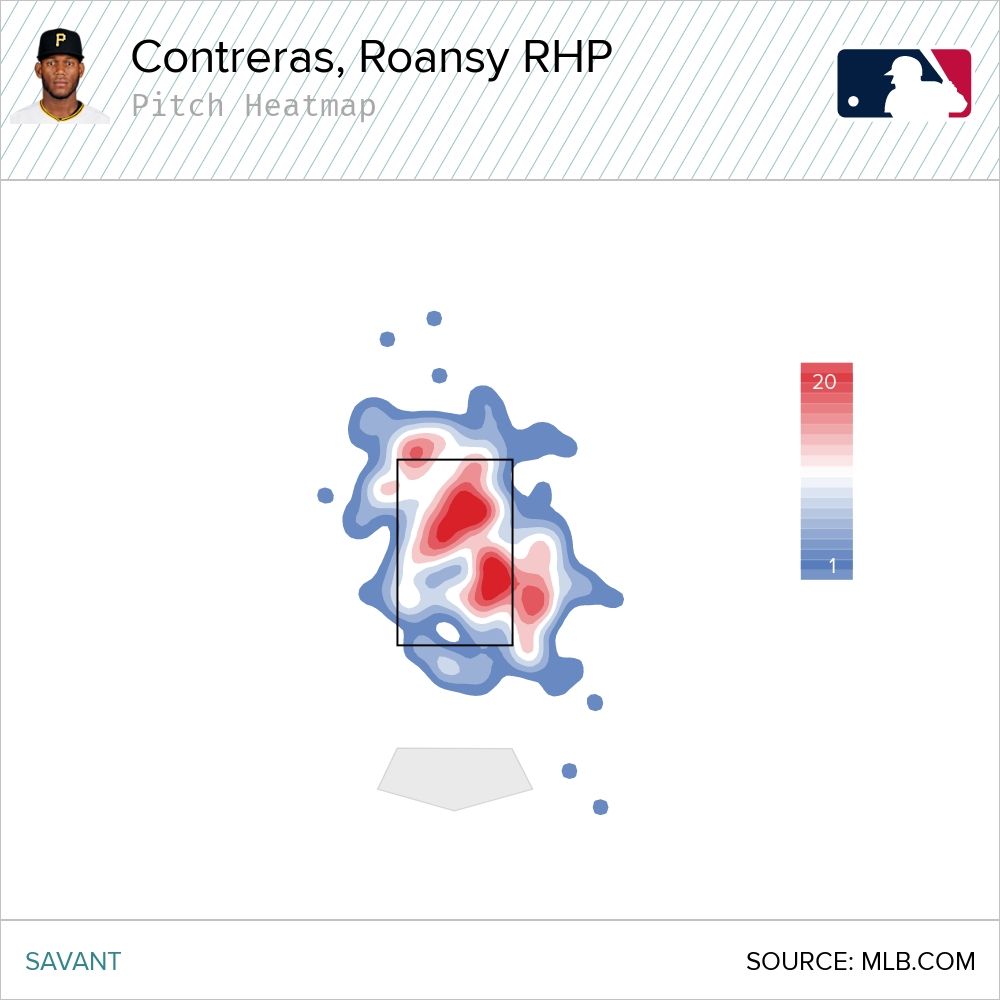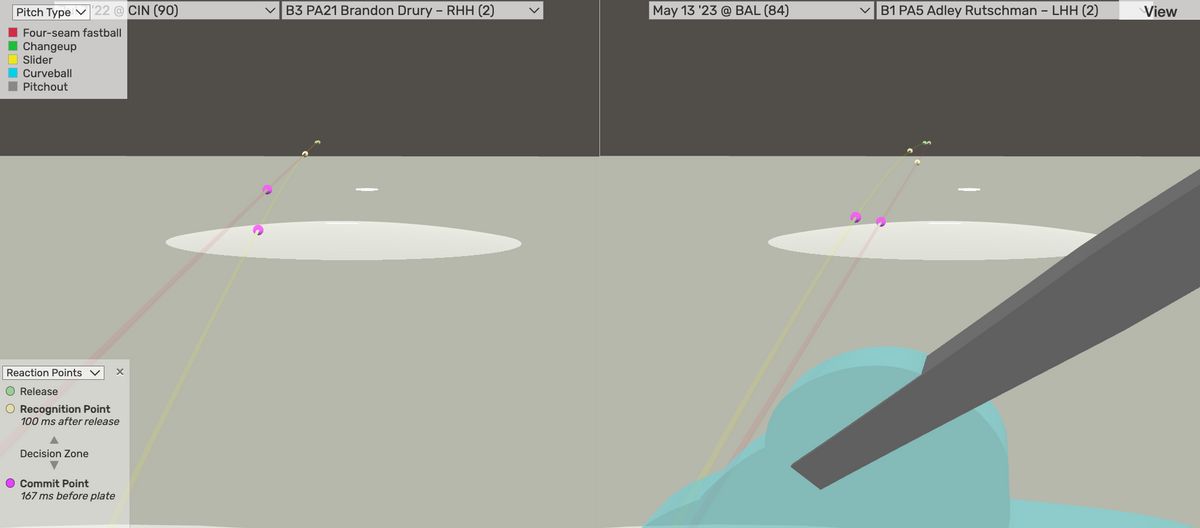SAN FRANCISCO -- This hasn't been the sophomore season many had hoped for from Roansy Contreras. He experienced some bumps along the way a year ago, some due to him needing to build up his innings thrown, a planned shutdown and his fair share of the usual rookie pains. But all told, a 3.79 ERA (108 ERA+) and 1.3 WAR over 95 major-league innings was still a very encouraging sign for a 22-year-old who looked to be a big part of the 2023 rotation plans.
Right now, though, that status in the rotation seems questionable.
The Pirates skipped over Contreras' start Saturday in favor of Vince Velasquez, the latter of whom was placed on the injured list again Sunday after his first start back did not go as planned. Ben Cherington said on his weekly radio show Sunday that the team had planned to temporarily move Contreras to the bullpen before Velasquez's injury.
On Sunday, Contreras pitched two innings of scoreless relief in the 6-3, 10-inning loss in Seattle.
"Roansy is a starting pitcher long-term in our opinion and we have confidence in putting him back in there," Cherington said.
"Definitely a new role for me, but if that's what the team wants, I'll be ready to come out of the bullpen and do my job either way," Contreras said via interpreter Stephen Morales after the game.
Contreras has the stuff to be a middle or front half of the rotation starter, but he hasn't shown it in 2023. Results wise, his 4.33 ERA and 4.54 FIP are basically league average, but that's only part of the story. Many of his peripherals paint a less optimistic picture. His 90.2 mph average exit velocity ranks in the bottom 25% of pitchers. His strikeout rate has dropped from 21.1% to 16.4%.
And then there is the pitch that is causing him the most trouble, the fastball. I touched in an earlier Mound Visit that Contreras is leaning on his slider more than ever before this season. Even he thought he was throwing the breaking ball too often and he tried to incorporate the fastball more in his following starts. Over his past three outings, he's upped his fastball usage but still allowed 10 runs over 17 innings innings, walking seven compared to eight strikeouts.
Perhaps the real takeaway is Contreras' jump in sliders isn't just because it's a good pitch, but because the four-seamer has been a bad one. Going by Baseball Savant's run value, the -10 runs Contreras' slider has been worth this year makes it one of the 10 most valuable pitches in baseball. The +8 runs his four-seam has been worth also makes it one of the 10 least valuable pitches in the sport.
The fastball wasn't a great pitch for Contreras a year ago, but it got the job done and let his breaking stuff play up. It also got a healthy 17.9% whiff rate, so it could be used to miss bats. Entering Sunday, hitters had a .394 batting average against the four-seamer with .452 wOBA and .450 xwOBA. The whiff rate has also plummeted to 7.4%. Entering Sunday, of the 120 pitchers who had thrown at least 100 four-seamers that a batter swung at, that whiff rate with the pitch was the second-lowest in the sport.
If you have been watching Contreras this year, you can probably guess what one of the main factors for this decline is: His velocity has dropped. He threw a little harder back in April of 2022 because he was being used out of the bullpen, so the real drop in velocity happened in September after he came back from his planned shutdown. It's down even more this year, averaging just over 94 mph:

Contreras does have that velo in him, though. His fastball sat much closer to 96 mph Sunday. It was a shorter outing, but consider it proof that he still has upper-90s stuff in that right arm.
“If he wanted to come out today and hit 97 mph, he could,” Cherington said earlier this month. “But because the slider is so good and he can use the curveball, it’s about more than velocity. It’s about keeping his fastball lanes [command] and letting the breaking ball play off it.”
Let's look at those fastball lanes, starting with command. It's apparent Contreras is not locating the way he needs to. His slider can move around the zone, but generally speaking, it will land right around the edge of the plate on his glove side, right around the batter's knees or a little above. The fastball on the other hand? Well, there is no trend this month, other than they are center-cut:

Major-league hitters are going to be able to hit 94 mph fastballs in those zones. Contreras does have that slider to fall back on, but a case can be made the fastball is hurting those pitches, too.
In this author's opinion, Contreras' best start in 2022 was his final outing before his midseason shutdown, when he went six innings of one-run ball with seven strikeouts and one walk against the Reds on July 7. He attacked the zone, he had his pitches working, it checked just about every box you want to see from a young pitcher. I also want to take his start against the Orioles this month, where he only allowed two runs but had difficulty missing bats and was barreled up often.
Here are two at-bats that went fastball-slider from the view of a left-handed hitter. The one on the left (to Reds right-hander Brandon Drury) shows how the sequence should go: Fastball up, slider down, quick out. The one on the right (to Orioles left-hander Adley Rutschman) shows what happens whenever that fastball misses low. The slider goes to the same spot as the fastball, and the point where Rutschman has to decide when to swing (the purple dots) is virtually in the same spot as it was the pitch before with the fastball:

That's the difference between a quick out against Drury and a home run against Rutschman:
Mashing 'n splashing pic.twitter.com/f8UW8QM0AK
— Baltimore Orioles (@Orioles) May 13, 2023
Is a trip to the bullpen a reason to panic for Contreras? Absolutely not. The Pirates did the same thing with Mitch Keller almost exactly one year ago, and that turned out swimmingly. Perhaps Contreras could also benefit from a sinker, if for no other reason than it could potentially tunnel better with that slider.
But at the moment, Contreras has issues with his fastball, and it extends beyond velocity. He's going to have to rectify it if he is going to reach his full potential on the mound.
